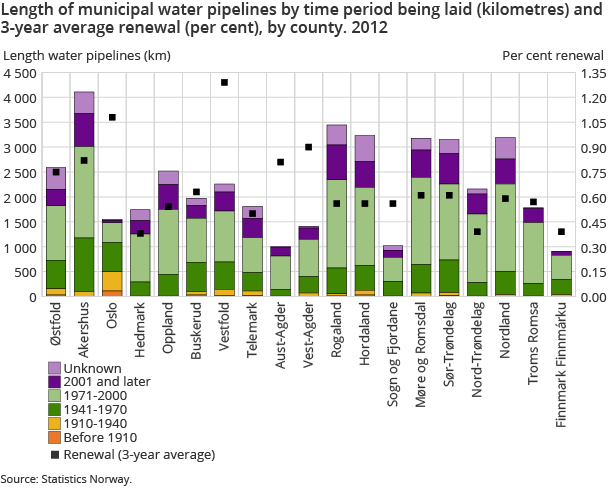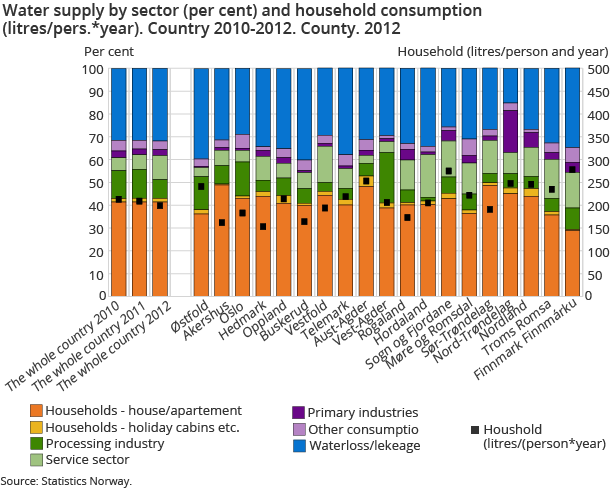Content
Published:
This is an archived release.
Half an hour of delivery failure
The estimated average annual technical delivery failure in municipal water supply in 2012 is around 30 minutes per person. Forty per cent of this are related to unplanned incidents by the water works.
| 2008 | 2011 | 2012 | Change in per cent | ||
|---|---|---|---|---|---|
| 2008 - 2012 | 2011 - 2012 | ||||
| Per cent of population connected to municipal water supply | 85.5 | 84.1 | 84.8 | -0.8 | 0.8 |
| Average household consumption per person per day (litre) | 198 | 209 | 199 | 0.5 | -4.8 |
| Per cent of total water pipeline system renewed, 3-year-average | 0.630 | 0.629 | 0.659 | 4.6 | 4.8 |
| Percentage of population supplied with hygienically safe drinking water with regard to E. Coli | 98.7 | 98.5 | 99.0 | 0.3 | 0.5 |
| Operating expenditures per inhabitant connected to municipal wastewater facilit | 712 | 815 | 815 | 14.5 | 0.0 |
| Fee calculation basis per inhabitant connected to muncipal distribution | 1 099 | 1 180 | 1 154 | 5.0 | -2.2 |
Around 3 900 leakage repairs were also estimated to have been carried out on the water pipeline system in 2012, corresponding to 1 leak repair per 10 kilometres of pipeline. This is around the same level as in 2011.
Half the pipeline system from 1971-2000
The length of the municipal water pipelines is estimated to be nearly 43 000 kilometres; the same as the earth’s circumference at the equator. About half of the municipal pipeline system was laid between 1971 and 2000, around 4 per cent was laid before 1940 and 16 per cent between 2001 and 2012. There are large differences in the age and quality of the pipeline systems between municipalities.
The age of the pipeline system for the country as a whole is estimated at 33 years. When corrected for pipelines laid in an “unknown time period”, the estimate changes to 34 years.
0.7 per cent renewal of the pipeline system
The renewal rate of municipal water pipelines varies from one year to another. Calculated as a 3-year moving average for the period 2010-2012, the rate of renewal is 0.7 per cent of the total pipeline system – an increase of 0.1 percentage point compared to 2011.
Today’s renewal rate means that it will take almost 150 years to renew the whole pipeline system, assuming that no new pipelines are installed in the coming years.
fig-2013-06-21-01-en; Length of municipal water pipelines by time period being laid (kilometres) and 3-year moving average renewal (per cent). County. 2012.
Drinking water under “pressure”
Booster pumps are used in many areas of Norway in order to transport drinking water to consumers. There are a total of 2 319 such pumps in the country, which corresponds to an average of 1 booster pump every 20 kilometres of water pipelines. If the pressure was to drop, there is a risk that polluted water from the outside may come into contact with the drinking water inside the pipelines. Thus, it is important to reduce pressure drops to a minimum by renewing old pipelines and having good routines for planned stops in the water supply.
199 litres a day per person
KOSTRA statistics on water supply show that more than 41 per cent of water to the municipal water pipeline system is consumed by households. An additional 2 per cent is consumed in holiday cottages or holiday homes. In one year, this corresponds to 199 litres a day per person; a 10-litre decrease compared to 2011.
Altogether, the municipal waterworks produced 724 million m3 of water, compared to 740 million m3 in 2011. One out of three litres, or around 32 per cent, of the water supplied is “lost” through leakage.
Satisfactory water quality
Around 4.3 million inhabitants in Norway were connected to the 1 096 municipal water works located in the country. This corresponds to a share of 85 per cent of Norway’s population. Dispersed across the water distributing system, this implies an average of 100 persons per kilometre of pipeline.
In 2012, a total of 99, 82 and 94 per cent of inhabitants respectively were connected to municipal waterworks that provided water with satisfactory content of thermo-tolerant intestinal bacteria (E. coli), colour and levels of acidity (pH).
Income from fees and fee calculation basis almost equal
In 2012, the fee calculation basis per inhabitant was NOK 1 154, which is just 0.6 per cent lower than 2011, but a 7 per cent increase compared to 2008.
Municipal costs in the water sector are predominantly covered by fees paid by the users of the service. Regulations stipulate that fees in the municipal water and wastewater sector cannot exceed the municipality’s actual costs for providing that particular service (“self cost”). Accurately stipulating income from fees to cover the real calculation basis in a single year is complicated, thus, the municipalities are allowed to decide on fee levels so that income from fees over a five-year period equal the fee calculation basis.
The income from fees was slightly higher than the fee calculation basis in 2012, but overall for the five-year period 2008 to 2012, the total income from fees was around 2 per cent lower than the total fee calculation basis. For the last four years, the sum of income from fees and the fee calculation basis are almost equal, with income from fees around 0.6 per cent lower than the fee calculation basis.
Contact
-
Gisle Berge
E-mail: gisle.berge@ssb.no
tel.: (+47) 48 12 19 97


